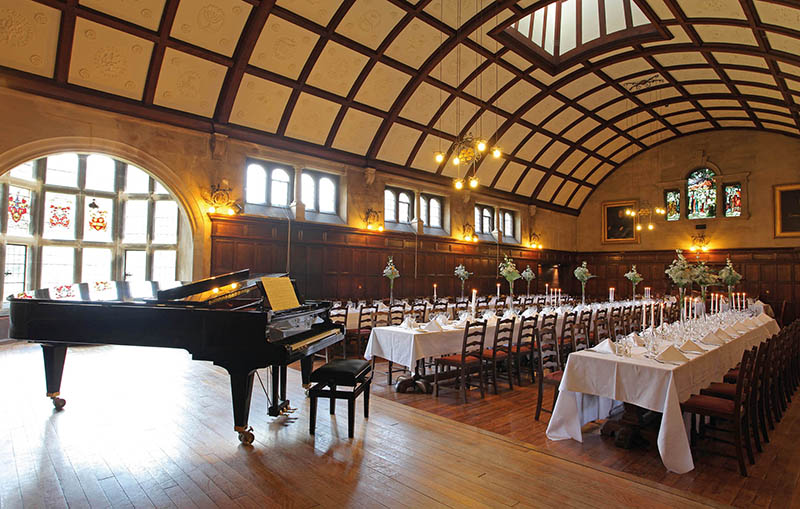The first attempt is a failure.
I can feel something with my knife – it’s sticky and hard to cut – then it drops. I try again, silver navigating tinkling china, lifting it gently, then: success!
A small, warm hand finds mine and an accompanying voice enquires, “Are you still there?” I am, I reply, mouth full. Even if my table manners slip, no-one will know, as not a soul at this dinner table, myself included, can see.
It’s always a privilege to dine in one of Cambridge’s beautiful formal halls, except this time, the beautiful vaulted ceiling and wood panelling of Westminster College are lost on the diners below. Tonight, thanks to an inspired idea by CamSight, we were Dining in the Dark, allowing us to experience, if just for one evening, the challenges of living with limited or no sight.
Dining in the Dark is held twice a year in Cambridge, usually at the Black Bull in Balsham or the Red Lion, Hinxton. Tickets are so popular, however, that this time organiser Sally Nott approached Westminster College to lay on a full-scale feast for 85.
The dinner begins as most do, with drinks and chatter before groups gradually find their seats and await the arrival of the first course. Next to our napkins are black eye masks, which we’re instructed to put on as the servers appear with our mysterious starter. The whole menu is a secret, and throughout the evening we’re encouraged to try and identify as many flavours as we can.
Blindfolds on…
As I affix my blindfold, my world goes dark and my ears sharpen. I’m instantly aware of the buzz of chatter in the room and the step and swish of the servers as they pass close behind me. I catch a waft of someone’s perfume. I also feel conspicuous, aware of my body seated in the chair. After a few moments I realise the conversation on my table has dwindled – a result of each of us turning our thoughts inwards and the difficulty of striking up a conversation without eye contact. Happily, there’s the food to discuss.
Sally explains to the room that there’s something on our plates at 9 o’clock, 12 o’clock and 3 o’clock. Locating my plate and cutlery with my fingers, I plunge in with my fork and meet a soft object. “Oo, I’ve got something chewy,” someone nearby exclaims. I slice, blindly, though I’ve no way of knowing how big a chunk I’ve cut, then find my mouth and chomp. Smooth and cold with a crumbed, meaty accompaniment, this unmistakable taste of picnics and homely lunchtime snacks is definitely a scotch egg.
The other objects don’t prove quite so easy to determine – one is gristly (I’d have cut that off if I’d seen any fat) and the other is something runny, with tomato and onion. Not being able to visualize it, the flavours seem duller: clearly the information our eyes send our brain play a large part in our ability to taste.
Starters finished (assuming we’ve not missed something on our plates), and flavours discussed, we’re allowed to remove our blindfolds for the main. The room is blinkingly bright and it turns out I’ve nudged a few morsels onto the tablecloth (though thankfully not spilt anything down my ill-advised cream dress).
‘Sight is important in the anticipation of eating, locating the food on the plate… You don’t even know if someone’s left the table unless they say so’
The process repeats for dessert and the staff conscientiously announce themselves as they lean in to deliver our plates. Once the final dishes are cleared, we return to the room to list the flavours we thought we tasted. It turns out there were 45 different ingredients used, and the ginger icecream I was sure I tasted was actually cinnamon; the chewy item venison tartare with gherkin (!) and the sticky pastry item we’d thought might be apple and caramel was a pineapple tarte tatin.
I discuss this mind trickery with Sally afterwards. “We all found this evening that your brain can play tricks and tell you you’re tasting something you’re not,” she agrees. “When you don’t know what’s there, you imagine instead what you’re eating, and sometimes you get it completely wrong!
“We’ve been doing these events for about four years and the idea is to give people an idea of how important sight is to the enjoyment of food,” she adds. “Sight is important in the anticipation of eating, locating the food on the plate… You don’t even know if someone’s left the table unless they say so. We hope the events give people something to think about as well as a good time.”
Dining in the Dark is a fascinating, humbling experience which really brings to the fore how important our sight is to everyday events such as enjoying a meal – and how much we take that gift for granted. And, living in such a beautiful city as we do, it hit home how easy it is to overlook and undervalue the world-class, painterly scenes we’re met with every day.
Most importantly, it’s a reminder that everyone can benefit from seeing the world as someone else does – even if that means not seeing it at all.
How to get involved: The next Dining in the Dark will take place next spring – sign up to the CamSight newsletter online. You can also volunteer by visiting people in their homes, reading, driving and helping at social events.

